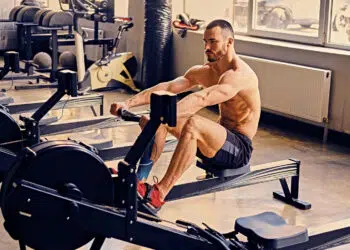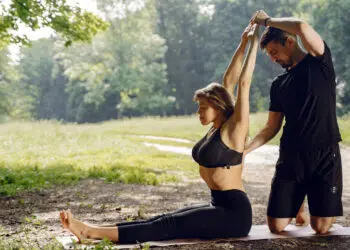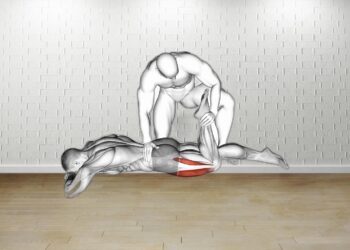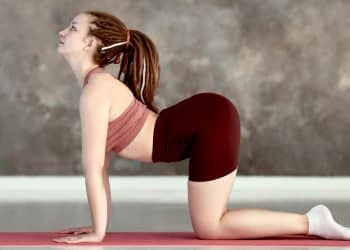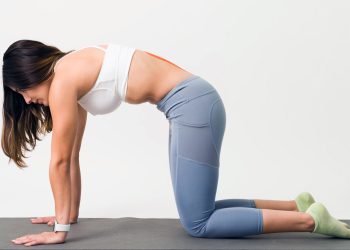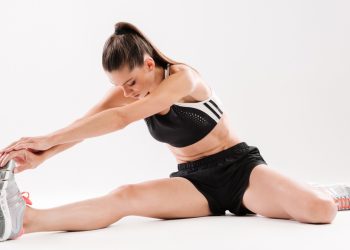The lying hip flexor stretch is a classic way to loosen up the crucial psoas and iliacus muscles, but also the surrounding muscles of this all important joint. Without adequate motion in the hips, you can forget about participating in physical activities such as sports, getting deep into a squat, or comfortably completing everyday tasks like walking up stairs, putting on your socks and shoes, and crunching down to pick up an object.
In this guide, you learn simple step-by-step instructions to perform the lying hip flexor stretch and more including how to tell if your hip flexors are overly tight.
What Are Hip Flexors?
The hips are a large gang of muscles that attach the legs to the pelvis and vertebrae (spine). However, there are five muscles that flex the hips.
- Iliacus
- Psoas (major and minor)
- Rectus femoris
- Iliocapsularis
- Sartorius
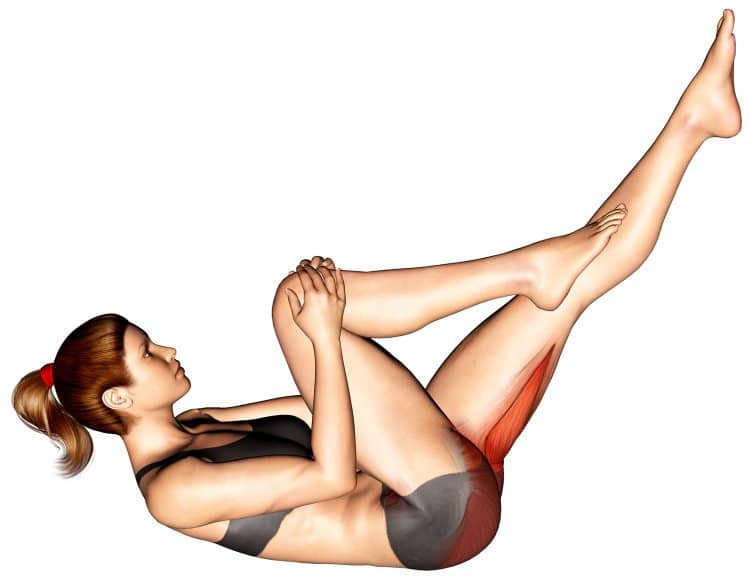
Out of these muscles, the iliacus and psoas (collectively referred to as the iliopsoas) are considered the primary hip flexors as they are not only the largest of the bunch, but also the most important. While the other three muscles bend the hips to 90 degrees, these two muscles function together to draw the knee up much higher (e.g., pulling the knees into the chest).
Let’s talk a little about the iliacus and psoas muscles.
Psoas
The psoas (pronounced so-as) is a hip flexor that forms the iliopsoas with the iliacus. It connects from the lower back through the pelvis and attaches onto the upper part of the femur (thigh bone). Its job is lateral rotation of the thigh and lateral flexion of the trunk. It’s also a postural muscle, stabilizing the vertebral column during standing.
Level Up Your Fitness: Join our 💪 strong community in Fitness Volt Newsletter. Get daily inspiration, expert-backed workouts, nutrition tips, the latest in strength sports, and the support you need to reach your goals. Subscribe for free!
Iliacus
Iliacus is a hip rotator muscles that flexes the thigh and supports upright posture. It forms the iliopsoas (primary hip flexor) with the psoas hip muscles.
How To Do The Lying Hip Flexor Stretch
The lying hip flexor stretch is so simple that anyone can do it so long as they have some mobility in their hips. But it’s also a great way to help maintain and improve movement in the lower body. Not to mention, you don’t need any special equipment and it can even be done from a bed or couch.
Before performing this stretch you should ideally do a light activity to get the muscles warm and stretchable.
To do the lying hip flexor stretch:
- Lie on your back with bent knees and feet flat on the floor. You can use a cushion to rest your head on.
- Grab the top of either shin (below the kneecap) or the back of your thigh below the knee with both hands.
- Pull your leg back toward your chest and hold for about 30 seconds.
- Perform the stretch on your opposite leg.
- Repeat two to three times per side.
Also check out the video demonstration of the lying hip flexor stretch below.
Do You Have Tight Or Weak Hips?
While stretching is a healthy activity for many reasons, make sure that what you may think are tight psoas muscles aren’t actually just weak hip flexors. A few simple ways to identify tight hips are if you experience pain while stretching in a standing lunge position or if you feel compression in your lower back during movements where the back is arched.
But there are tests that you can perform to determine whether your hips are tight or weak.
Hip flexor tightness test
To do it:
- Sit on the edge of bench with half of your upper legs hanging off the edge.
- Lie back on the bench and bring your knees up toward your chest.
- Grab either knee and pull it into your chest, then let the other leg drop down onto the bench. Make sure your lower back is flat on the bench and not arched.
- If the bottom leg makes full contact with the bench then you probably don’t have tight hips. However, if the knee of that legs remains flexed and raised off the bench then you have tight hip flexors.
Hip flexor weakness test
To do it:
- Stand with your feet together and arms by your sides.
- Lift either leg to about hip height with your knee bent at roughly 90 degrees.
- Hold your leg up for as long as you can.
- Repeat the test on the opposite side.
Make a mental note of the results.
If you fail to keep your leg up for longer than 30 seconds or your lower back arches, you probably have weak hip flexors.
6 Lying Hip Flexor Stretch Benefits
The benefits of stretching your hip flexor muscles is worthwhile. In fact, stretching, in general, is a proven effective method of bodily maintenance.
1. Maintain hip flexibility and mobility
Being such a large and important muscle group for every day movement and activities, tight hips are much worse than having tight biceps. After all, the hip flexors assist us during everyday tasks that require function of our legs (e.g., walking, squatting, etc).
It’s especially crucial for elderly individuals to maintain flexibility in the joints as these areas tend to be less mobile with age.
2. Spine stability
The hip flexors play an important role in spine stability and when the hip flexors are tight many people experience pain in this area which is another important reason to stretch these muscles regularly. (1)
Level Up Your Fitness: Join our 💪 strong community in Fitness Volt Newsletter. Get daily inspiration, expert-backed workouts, nutrition tips, the latest in strength sports, and the support you need to reach your goals. Subscribe for free!
3. Knee health
Tight hips can be a problem for the knees because it affects movement of the femur bone which can throw off the regular alignment from the hips to the knees.
Related: How to Squat and Build Better Legs with Bad Knees
4. Alleviate pain
To extend from the previously mentioned benefit, you want to maintain mobility and flexibility for the spine but also when you’ve pulled or torn muscles in the hips.
5. Improve posture
Anterior pelvic tilt is an issue caused by tight hip flexors, which also affects our body posture. Keeping the hip flexors loose can help us to maintain a healthy and upright posture.
6. Athletic performance
If you have tight or even weak hip flexors, your athletic performance will suffer. Maintaining a full range of motion in the hips is crucial for maximizing your athletic efforts including your stride length, jumping ability and other important factors of physical performance.
One study concluded that stretching the hip flexors can improve sports performance but also prevent injuries. But you certainly want to ensure that you do it safely and effectively. (1).
Variations and Alternatives
The lying hip flexor stretch is a popular way to loosen up tights hips. But these are great variations and alternatives that you may like just as much or even better.
Half kneeling/lunge
Another very popular hip flexor stretch is the half kneeling/lunge variation. It’s not necessarily better than the lying version, however, it’s just a different way to do it.
To do it:
- Start in a tall kneeling position on your knees.
- Bring one leg forward into a lunge position with the knee bent at a roughly 90-degree angle.
- Push your hips forward until you feel a good stretch in the hips while remaining as upright as possible. Do not lean forward during the stretch.
- Hold for at least 10-15 seconds.
- Reset and repeat two to three times then switch legs.
Glute bridge stretch
Nearly as simple as the lying hip flexor stretch, the glute bridge stretches the iliopsoas but it can double as a butt and hamstring workout.
To do it:
- Lie on your back with your knees bent and feet flat on the floor.
- Tense your glute muscles and lift your hips up until you feel a good stretch in your hip flexor muscles .
- Hold for 10-20 seconds.
- Slowly drop your butt to the floor and repeat for the desired number of repetitions.
Table hip flexor stretch
If you prefer to remain standing, this is one of the best variations or a great alternative to the lying hip flexor stretch. Ideally, you’ll have access to a platform between the height of your knees and waist (e.g., massage table, desk, kitchen counter, high bench, etc.) so that you can keep the non-target leg mostly extended.
There are also a few different variations within this variation.
To do it:
- Keep one foot on the ground and lie face down on the platform with the other leg straight out on the table. From there you can lift up onto your forearms by lifting your chest, or extend both arms on the bench to get a good stretch. Adjust your foot forward for a deeper stretch in the hip flexors.
What Causes Tight Hip Flexors?
There are two main reasons for tight hip flexors…
Too much sitting
Let’s face it, we’re sitting on our behinds more than ever before, and that’s not a good thing. The psoas and iliacus muscles are in a shortened position for extended periods which causes the body to adapt and therefore, these hip flexors become tight.
High heels
No we’re not only referring to the common women’s fashion staple, but rather many different types of footwear that lift our heels higher than the toes. Well, this causes a change in our posture such as tilting the pelvis forward which also shortens the primary hip flexors (iliacus and psoas).
Bottom Line
The lying hip flexor stretch is a classic, basic stretch for the main hip flexor muscles – iliacus and psoas. While there are many techniques to loosen up this commonly tight and troublesome area, this variation can offer quick and convenient relief, so long as you have some mobility in the hips. But we also recommend trying more advanced stretches too.
Stretching has been shown to have many benefits for the body and mind, and the hips are one of the most important areas for general health and well-being.
Interested in measuring your progress? Check out our strength standards for Squat, Glute Bridge, Lunge.


